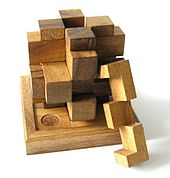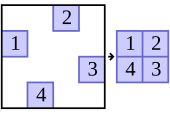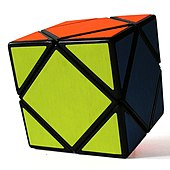Mechanical puzzles
Mechanical puzzles or mind or puzzle games are a category of puzzle games in which the problem must be solved by manipulating the whole object or parts of it. The games are mostly designed for a single player (so-called solitaire game ). The aim is for the player to see through the principle of the object, and less so that he comes across the correct solution by chance through the heuristic method of trial and error . They are therefore often used as an intelligence test or in problem-solving training.
One of the most famous puzzle games is the Rubik 's Cube, invented by Ernő Rubik in 1974 . An old Eastern puzzle game is Tangram from China, which was made between the 8th and 4th centuries BC. Was invented. Probably the first documented western mechanical puzzle game dates from the 3rd century BC. From Greece. Thereafter, a multitude of other games with the same gameplay were invented.
history

A first traditional puzzle game is Tangram , which was made between the 8th and 4th centuries BC. Originated in China . There, animals, ships or other shapes have to be placed out of tiles that have been cut out of a square.
The Stomachion is a document by Archimedes (3rd century BC) that contains a puzzle. There are 14 parts to be joined to form a square. In Iran puzzle locks were made in the 17th century. The next known games come from Japan . A book from 1742 mentions a game called "Sei Shona-gon Chie No-Ita". In 1870 or 1880 an unsolvable puzzle game came on the market, which became known as the 15-Puzzle . Today similar but solvable puzzles are in stores. In 1820 the tangram game spread throughout Europe and America. The Richter company from Rudolstadt produced large quantities of tangram-like games in various forms, the anchor puzzles, from 1882 onwards. In 1893, Professor Hoffman published a book called "Puzzles Old and New". Among other things, it contained more than 40 descriptions for puzzles with secret opening mechanisms. This book developed into a kind of standard work for puzzle games. Modern editions exist for those who are interested. Otherwise, the turn of the 20th century was a time when puzzle games were very much in fashion. First patents on puzzle designs have been registered. For example in 1890 a game by Wilhelm Altekruse , which consisted of 12 identical parts (see picture). With the invention of inexpensive malleable materials like plastic, the door was opened to further possibilities.
variants
Puzzle games
In this category, the game is available in individual parts and a target form must be generated. These games include the Soma cube by Piet Hein and the Pentominos by Solomon W. Golomb , as well as problems in which a number of pieces have to be put into a box (which usually appears much too small), and finally the group of laying puzzles with tangram and the Placement games by the Ankerwerk in Rudolstadt . There is also a series of puzzles called Happy Cubes , where three-dimensional objects can be put together from two-dimensional parts.
The picture shows a variant of Hoffman's packing problem . Pack 27 identical cuboids with the edge lengths A, B and C in a cubic box with the (inner) edge length A + B + C, whereby the following two conditions must apply: A, B and C must be different and the smallest side length must be greater than be. A possible variant for A, B and C are 18, 20, 22. The box must then have internal dimensions of 60 × 60 × 60.
Modern machines such as laser cutters make it possible to cut complex 2-dimensional puzzles out of wood or plexiglass . These possibilities have been used more and more recently and games with unusual decorative geometric patterns have been designed. Here, the whole variety of possible regular division of space can be used.
The computer is also helpful for new ideas. It allows the exhaustive search for solutions. With its help, the game can be designed so that it has as few solutions as possible and thus becomes relatively complicated.
Working with transparent materials allows puzzles in which the parts have to be stacked on top of each other. Patterns, images or color gradients must then be visible in the solution. For example, there is a game that consists of several discs on which individual angular sections are colored differently. These discs must be stacked in such a way that a color circle (red → blue → green → red) is visible around the discs.
A game that is easy to implement is the nail game: it consists of a number of nails. The task stipulates that all nails should be carried by a single nail. The solution is a construction in which the nails interlock and then balance on a nail head.
Breakdown Games
Puzzles in this category are usually intended to be opened or broken into several pieces. This type of box includes boxes with secret locking mechanisms that the puzzler has to open by trying. This category also includes metal games in which several parts are interlocked.
The two games shown in the picture are particularly suitable for the coffee table, as they trick the player into thinking that it must be very easy to take them apart. But many people don't get them apart at all. The problem lies in the shape of the teeth: They are conical and therefore only allow removal in one direction. This direction is the same for all parts, so that you can only move the parts a little at a time. One direction is blocked by your own tooth, as this is then stuck in the eye of the previous part due to its conical shape. In the other direction, your own eyelet gets stuck in the tooth of the next part.
This category also includes the boxes with secret opening mechanisms, which are extremely popular in Japan. These boxes contain more or less complicated, mostly invisible, locking mechanisms that ultimately release a small cavity. The mechanisms range from barely visible panels that have to be moved, to tilting mechanisms, magnetic locks, movable pins that have to be brought into a certain position with rotation , to time locks in which the object must be held in a certain position for a certain time until a liquid has filled a vessel.
Interlocking objects
Interlocking puzzles are, for example, the well-known Chinese wooden knots, which are sometimes also called devil's knots. The task is to take the game apart and then put it back together again. Both actions can be complicated. In contrast to the assembly puzzles, interlocking puzzles do not simply fall apart. The level of difficulty of these puzzles is indicated as the number of moves it takes to remove the first piece from the puzzle when it is disassembled. The picture shows the most famous representative of this category, the Chinese wooden knot. This version, designed by Bill Cutler, requires 5 movements before the first part can be removed. The known history of these games goes back to the beginning of the 18th century. In 1803 Georg Hieronimus Bestelmeier's catalog contained two puzzles of this type. Professor Hoffman's book also contains two interlocking puzzles. At the beginning of the 19th century, the Japanese took over the market for these games. They developed a variety of games in the form of animals, houses and other objects, whereas the development in the western world remained with geometric shapes. Recently it has become possible to use computers to perform analysis on complete sets of these games. Bill Cutler started this process with his analysis of all Chinese wood knots. From October 1987 to August 1990 35,657,131,235 different variants were analyzed. The calculations were carried out on several computers and add up to a total calculation time of 62.5 years. In other analyzes for other forms, new amazing developments come to light regularly. The level rose in sizes of up to 100 trains that were impossible for humans to grasp. The end point in this development is a game in which you can double the number of moves by adding a few pieces. However, computer analysis has also encouraged another development: rotations of parts cannot yet be analyzed with the programs currently available. As a result, various puzzles were developed that require at least one rotation to solve. These have to be solved again by hand. Puzzles without right angles cannot be solved efficiently with computer programs at the moment. Stewart Coffin has developed many games based on the rhombic dodecahedron , with hexagonal or triangular bars since the 1960s . His games often have extremely irregular partial forms, which then come together in the final assembly step to form a regular object. In addition, the 60 degree angles allow designs where multiple objects have to be moved at the same time. Stewart Coffin's “Rosebud” puzzle marks a high point in this possibility. In this puzzle, 6 pieces have to be moved simultaneously from an extreme position where they only touch at corners to the center of the finished object.
Unraveling games
Interlocking linear ring puzzle analogous to the Chinese rings . Exponential number of solution steps corresponding to the number of rings.
A type of disentangling game is called a puzzles in which two or more knotted metal wires have to be loosened from each other. These games too had their first widespread use at the end of the 19th century with the general puzzle craze. A large number of puzzles that are still available today have their origins in this period.
The task in untangling games is usually to loosen a metal loop or a loop of thread from an object. Topology plays a big role in these games. Simple representatives of this category can still be solved by random trial and error. More complex variants require repetitive solution patterns which, even with knowledge of the complete solution, involve a relatively high time requirement.
A prominent type of puzzle are ring puzzles, which also include the Chinese rings. In these games, an elongated wire loop or thread loop has to be detached from a network of interlocking rings, loops and wires. The number of steps required is often exponential to the number of interlocking obstacles if these are linearly chained. There is a story about the Chinese rings that in the Middle Ages knights gave their wives this game so that the time would not be long for them while their husbands were out and about. In contrast to the Chinese rings, there are also unraveling games with interlocking obstacles that are not linear. The course of the rings branches and is brought together again, as in James Dalgety's Devil's Halo , for example , which increases the complexity of the solution. The branch idea came up in 1970. James Dalgety's Devil's Halo received the London Design Center Award in 1974. (Source: see web link )
Niels Bohr used an untangling puzzle called Tangloids to demonstrate the properties of spin to his students .
Folding games
In these puzzles, a piece of paper with imprints has to be folded in such a way that a certain target image is achieved. In principle, Rubiks Magic could be included in this category. Another, better example is shown in the picture. Fold the square piece of paper so that the four squares with the numbers are next to each other without any gaps, forming a square. This puzzle is pretty complicated.
Everyone has another problem with folding at home: leaflets, city maps and leaflets . Despite the visible direction at the folds, it is sometimes surprisingly difficult to fold the paper back up as it was delivered.
Puzzle locks
These are locks (often in the form of a padlock) that have an unusual locking mechanism. The task is to open the lock. With some locks, however, it is more difficult to restore the original condition. An example of a puzzle lock is the Himitsu Bako .
Confusing vessels
These are vessels with pitfalls. The task is to drink or pour from the vessel without spilling the liquid. One possible construction for a puzzle vessel is shown in the picture. The neck of the container contains many holes that do not hinder normal pouring, but make pouring impossible. Invisible to the puzzler, a line is built in through the handle along the upper edge of the vessel to the spout. If the opening at the upper end of the handle is now closed with a finger, you can drink liquid by sucking on the spout. Puzzle jars are a very old form of game. Even the Greeks and Phoenicians made vessels that had to be filled through an opening in the floor. In the 9th century there were a variety of different vessels in Turkey, which were described in detail in a book. In the 18th century, the Chinese also made such drinking vessels.
Games of skill
This category does not include puzzle games, as skill and perseverance are more required here. The goal is often to maneuver small balls into a hole by carefully tilting a box with a transparent lid. A contemporary version of classic ball mazes is the so-called perplexus -ball.
Games with movement sequences
Games in this category require repeated manipulation of the puzzle to bring the game to a very specific state. Well-known representatives are the Rubik's Cube and the Towers of Hanoi .
This category also includes all sliding puzzles in which one or more stones are to be pushed to a certain point. The best known representative is the 15 puzzle . Games like rush hour or sokoban are also sliding games.
Rotating puzzle
The Rubik's Cube caused an unexpected boom in this category. The variants of objects are unmanageable. In addition to cubes with the dimensions 2 × 2 × 2, 3 × 3 × 3, 4 × 4 × 4, 5 × 5 × 5, 6 × 6 × 6 and 7 × 7 × 7, there are also tetrahedra , dodecahedron and different shapes of cylinders. The different arrangement of the rotation axes allows different puzzles with the same basic shape. Furthermore, by removing levels from a cube, cuboid games can be obtained which, when manipulated, take on various irregular shapes ( shape shifting ). Another game is the masterball .
The picture shows another, less well-known representative of this genre of puzzle games. The game is still so simple that you can solve it with a little trial and error and a few notes, in contrast to the Rubik's cube, which is already too difficult to find a solution with trial and error.
Individual evidence
Web links
-
Gunnar's metal puzzles and puzzles blog
- This page contains reviews and information on current puzzles
-
Website of the Puzzleworld by Andreas Vahldieck
- This page contains the well-illustrated presentation of the collection, Java applets for various puzzles, solutions for desperate puzzle owners and a very extensive list of links on the subject of logic puzzles and puzzles.
-
Website of the puzzles collection of John Rausch
- In addition to a well-illustrated presentation of the collection, this page also contains a page with Java applets for sliding puzzles. The books by Stewart Coffin, one of the most important puzzle designers, are also available.
-
Puzzle designs prepared by ISHINO Keiichiro
- This page contains a huge collection of detailed descriptions for putting together and interlocking puzzles. If you have a skilled hand, you can create your own collection with the designs presented here.
-
Devil's Halo at the Puzzle Museum
- James Dalgety's website for the Puzzle Museum offers an overview of more than 5000 puzzles. Devil's Halo is a modern representative of unraveling games with a particularly high level of difficulty.
literature
- Jerry Slocum, Jack Botermans: Puzzles Old And New - How to make and solve them. Wellingborough 1987, ISBN 1-85336-018-X . (English)
- Jerry Slocum, Jack Botermans: The world's puzzles. Hugendubel, 1986, ISBN 3-88034-336-5 .
- Stewart Coffin: The Puzzling World of Polyhedral Dissections. Oxford University Press, 1990, ISBN 0-19-853207-5 .
- Stewart Coffin: Puzzle Craft 1985 Edition. Self-published, Lincoln, MA 1985, OCLC 12869349 .
- Stewart Coffin: Puzzle Craft 1992 Edition. (these books are available online from John Rausch's website)
- Edward Hordern: Sliding Piece Puzzles (Recreations in Mathematics, No 4). Clarendon Press, 1987, ISBN 0-19-853204-0 . (Main reference for sliding puzzles)
- Sophus Tromholt : Matchstick games: brain teasers and amusement. Spamer, Leipzig 1889 (new edition: Hugendubel Verlag, Munich 1989, ISBN 3-88034-298-9 ).
- Rüdiger Thiele , Konrad Haase: Devil games. Urania Verlag, ISBN 3-332-00116-7 .
- Pieter van Delft, Jack Botermans: Mind games of the world. Hugendubel Verlag, ISBN 3-88034-087-0 .
- Christoph Bandelow: Inside Rubik's Cube and Beyond. Birkhäuser Verlag, ISBN 3-7643-3078-3 .
- Tom Werneck : Magic pyamid (devil's barrel - Tower - Trikki 4). Heyne Verlag, ISBN 3-453-41473-X .
- Tom Werneck: The magic ball. Heyne Verlag, ISBN 3-453-41505-1 .
- Angus Lavery: Rubik's CLOCK. Heyne Verlag, ISBN 3-453-03216-0 .















